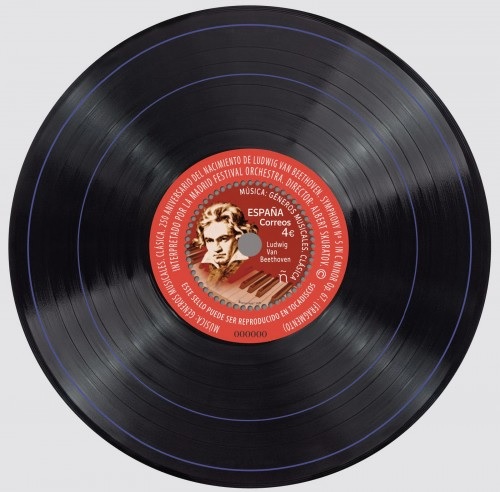On the occasion of the 250th anniversary of the birth of Ludwig van Beethoven, and within the series «Music. Musical genres",God willing, on November 9, 2020 a block sheet dedicated to the great German composer,with a postage stamp that presents the peculiarity of being able to be reproduced on a record player and listen in this way to a fragment of his Symphony No. 5, performed by the Madrid Festival Orchestra.
Technical characteristics:
- Printing procedure: Offset + die-cutting + musical audition of the 5th symphony fragment.
- Support: 320 gr / m2 rubberized cardboard.
- Perforation: 13 ½.
- Stamp format: 36 mm (circular).
- Block sheet format: 138 mm (circular).
- Postal value of the stamp: € 4.
- Sheet effects: 1 Block sheet with a stamp.
- Print run: 140,000 Block sheets.
A stamp that can be heard is the new issue that Correos dedicates to classical music.
The stamp, shaped like a vinyl record, can be put on a record player and played Symphony number five in C minor op. 67, performed by the Madrid Festival Orcherstra, under the direction of Albert Skuratov.
Ludwig van Beethoven was born in Bonn (Germany) on December 16, 1770, so this year marks the 250th anniversary of his arrival in the world.The melody that the seal reproduces was composed between 1804 and 1808. This symphony is one of the most popular and performed compositions in classical music. It consists of four movements: it begins with a sonata allegro, continues with an andante, and ends with an uninterrupted scherzo, comprising the last two parts.
Since its premiere at the Theater an der Wien in Vienna on December 22, 1808, directed by the composer himself, the work acquired a notorious prestige, which still continues today.
Classical music was born as a form of rupture against the strict rules of baroque music that were characterized by their horizontal structure where several melodies were superimposed at the same time.
It contrasts with the previous period for lighter compositions and for having only one main melody that was the one that guided all the instruments. This causes the same rhythm to be preserved in a succession of vertically structured chords called homophony.
Returning to vinyl records, in recent years the turnover from their sale had reached a figure that had not been seen since the 90s.This label includes classical elements such as a Beethoven symphony or the shape of a vinyl record, and others as innovative as the fact that a label can be heard on a record player.
(The above information has been prepared by the Post Office Philately Subdirectorate)

